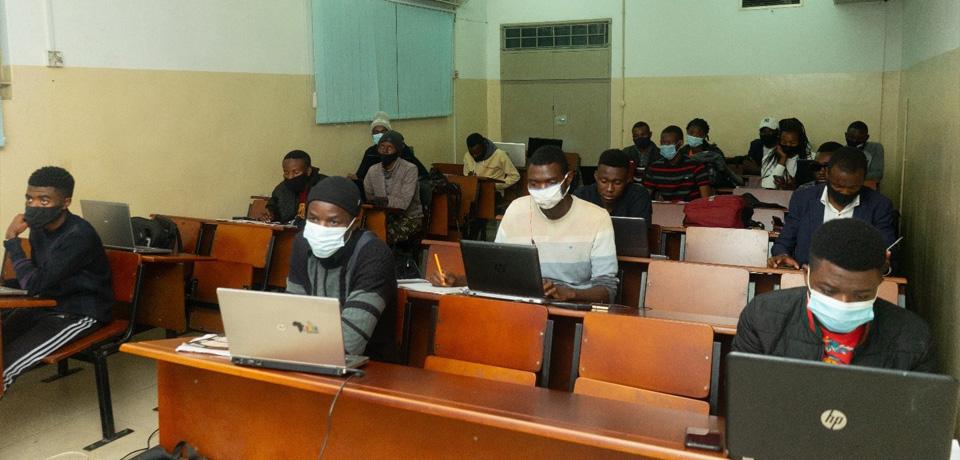
Daniel Makini Getuno, Sedina Misango, Mirriam Phiri, Christine Aoyo, Modestus Oseebe Namodi, Satu Määttänen & Eija Laitinen
Problem-based learning (PBL) is an innovative teaching concept, building upon interaction and learners’ own objectives. While PBL has been used in higher education within the Global North for a while, the practice has not taken root in Africa. In Africa, teaching traditionally entails passive learning, often ending up in the so-called spoon-feeding education. The teacher controls the learning process, feeding information and procedures to students, without requiring students to think, evaluate or apply information by themselves (Smith, 2008). This leads to rote learning which stifles innovation and creativity.
For sustainable development and economic prosperity, the African continent needs an innovative and self-imposed workforce (Monga et al., 2019). So why haven’t African higher education institutions (HEIs) adopted competency-based and student-centered teaching methods, such as PBL? We disentangle this question by presenting an example on the successful introduction of PBL to higher education in Germany. Then we scrutinize the challenges of PBL use on African HEIs, and present solutions to overcome them.
Educational paradigm shift – example from Germany
The TH Köln University of Applied Sciences in Germany incorporated PBL to education to provide students with world of work relevant competencies and to promote global citizenship (Heuchemer et al., 2020). The key to the success of the educational shift from “teaching to learning” was that the transformation to PBL happened in three levels (Heuchemer et al., 2020):
- The university level, by influencing teaching and learning culture and developing guidelines for teaching, making PBL realizable in other levels.
- The faculty, department and management level, by curricula development and structural changes in examination methods, regulations, and academic schedules, enabling PBL adoption and implementation at the course-level.
- The teacher and course level, by competence development through teacher training and coaching, and through the development of teaching portfolios.
Challenges of PBL adoption and implementation in Africa
Below we have compiled a list of factors affecting PBL adoption and implementation in African HEIs. The list is based on literature and on the perceptions of the authors consisting of university staff from four universities and three countries in Africa.
- Facility and resource constraints. Being highly practical, PBL often requires facilities and materials, such as physical infrastructure, logistical facilities, equipment and tools. These basic facilities and resources are often minimal or even absent, given the financial constraints of most African universities.
- Structural constraints. The current African curricula and related teaching and assessment methods, approved by the governments and educational systems, do not support the adoption of PBL. In addition, the frequent revision of PBL program, due to emerging issues in clinical or field practices, may become expensive in terms of money, labor, and time, all already scarce resources in many universities in Africa.
- Large class sizes. Large student numbers, a common setting in African universities, pose challenges to PBL (Dolmans et al., 2005). Large class sizes require several tutors and over-stretch the already scarce material and time resources of universities.
- Information overload. PBL can be complex, as it includes a lot of information, discussion, projects and approaches to draw from. Keeping up and guiding student teams and their activities may become tedious to the tutors. Multiple tutors together with numerous pieces of information and various activities can be overwhelming to students, interfering knowledge creation and application. There are management tools for reducing information overload, however, many African universities may not afford these learning devises and software.
- Time constraints. Team building, teamwork, knowledge creation together, and other PBL activities require sufficient time resources, which may be lacking in overcrowded universities. The time required for discussions or practical work can’t be precisely planned in advance, as the length of activities may vary (Søndergaard, 2016).
- Human capital constraints. Managing and evaluating students, student teams, and team activities, while accounting for different learning skills and ensuring the achievement of the learning outcomes, requires interpersonal skills and flexibility from tutors (Peterson, 1997). Pedagogical trainings to develop teachers’ skills are often limited in African universities. PBL requires various skills also from students. The point of PBL is to develop these skills, but the initial transformation to PBL may cause student frustration and resistance, hampering learning, and thus discouraging PBL implementation by teaching staff (McCowan, 2018; Peterson, 1997).
- Lack of technology. Practical aspects of PBL may be difficult to execute in African Universities that struggle to access technology due to financial and human capital constraints.
- Limited learning. Poor implementation of PBL, due to previously mentioned constraints, may lead to poor learning (Tang & Chow, 2020), further impeding implementation of the practice.
The way forward: Overcoming PBL challenges in African HEIs
Guided by the case study of TH Köln, we believe that to enable PBL, change is needed in all HEI management levels, as well as in the whole educational system. We have identified six main solutions to the challenges of PBL use in African HEIs:
- Human resource training. A training of HEI community is a key requirement for PBL implementation. Training builds understanding and appreciation for the need to change the teaching mode and roles within. Teachers must have knowledge and skills to be able to design relevant, real-life, problems, evaluate and monitor students, and guide team formation and management (Dolmans et al., 2005). Teachers must develop their creativity, flexibility, and patience, core attributes required by PBL facilitator. A basic understanding about PBL is crucial for management staff to be able to formulate strategies and design curriculum.
- Re-designing competence-based curriculum. Curricula design and development have a significant effect on learning (Stefani, 2008). Curricula should be reviewed in collaboration with industry and other stakeholders, to design more competence-based programmes that respond to emerging issues and demands on society (Alsubaie, 2016). Practical curricula aspects, such as pedagogy guides, workload, timetable, and assessment criteria should also be modified to enable PBL. Curriculum revision can either apply to the whole curriculum, or the curriculum can be “broken down” to enable PBL implementation in specific modules or courses.
- Providing required facilities and infrastructure. HEIs should be provided with adequate funds to embrace technological advances, acquire relevant facilities and infrastructure, and reduce student/staff ratios. To improve the financial situation and its optimal mobilization and use, HEIs can diversify their financial sources, promote the participation of the private sector, develop income-generating activities and organize distance educational programs (World Bank, 2010).
- University-industry partnerships. An interactive and collaborative arrangement between academic institutions and industry is important for PBL implementation. University-industry interaction can be promoted through the participation of industry in curriculum development, joint research programmes, research laboratories sponsored by industries, and practical training of students in industries (Menezes & Pinto, 2016).
- Careful planning. To enable encouraging experiences from PBL, the teaching and learning need to be carefully planned and designed. This is especially important for teachers practicing PBL for the first time (Heuchemer et al., 2020). Teachers may start incorporating PBL into their teaching with mixed-learning methods: by combining lectures and practical approaches as described by Aditomo et al. (2013).
- Overhauling the educational system. Competence-based curricula and modern teaching methods should be incorporated already into lower levels of education, i.e., primary and secondary levels, as well as into higher education. This will contribute to students’ skills development and reduce students’ and teachers’ resistance to implementing PBL in HEIs. Thus, it is necessary to revise the entire educational system in Africa through policy reforms.
This article has been written as part of a professional Problem-Based Learning Training Programme for East and Southern African university teachers. The training programme was organized as part of AgriSCALE project (https://www.agriscale.net/) activities during 2021. AgriSCALE is an EU-funded project coordinated by Häme University of Applied Sciences (FIN), that aims to reform agricultural education and curricula in East and Southern African universities. Project partners include nine universities from East and Southern Africa and Europe.
Authors
Daniel Makini Getuno, Lecturer, PhD candidate, MEd (Science). He works as the Head of Learner and Tutor Support at the E-Campus in Egerton University, Kenya.
Sedina Misango, Senior Lecturer, PhD. She is the Head of Department, Business & Entrepreneurship; School of Business & Economics in South Eastern Kenya University, Kenya.
Mirriam Phiri, Lecturer, PhD candidate, M.Sc. (Integrated Soil Fertility Management). She is a lecturer and researcher in the Department of Soil Science, at the University of Zambia.
Christine Aoyo, Part time Assistant Lecturer, Phd Candidate, MSC Agrienterprise development. She works as an assistant lecturer at the Dept. of Rural development and agribusiness in Faculty of Agriculture and Environment, Gulu University, Uganda.
Modestus Oseebe Namodi, Part-time Lecturer, PhD candidate, MBA (Management information systems). She works as a part-time lecturer at the department of accounting, finance, and management science, faculty of commerce in Egerton University, Kenya.
Satu Määttänen, M.Sc. in Arg. & For. and M.Sc. in Biol & Env. Sci. Research Assistant in Häme University of Applied Sciences at HAMK Bio Research Unit
Eija Laitinen, PhD in Adult Education, Principal Research Scientist in HAMK Bio Research Unit AgriSCALE and PBL-BioAfrica Project Coordinator and leader of the HAMK Africa Team.
References
Aditomo, A., Goodyear, P., Bliuc, A. M. & Ellis, R. A. (2013). Inquiry-based learning in higher education: Principal forms, educational objectives, and disciplinary variations. Studies in Higher Education, 38(9), 1239–1258. https://doi.org/10.1080/03075079.2011.616584
Alsubaie, M. (2016). Curriculum Development: Teacher Involvement in Curriculum Development. Journal of Education and Practice, 7(6), 106–107. https://files.eric.ed.gov/fulltext/EJ1095725.pdf
Dolmans, D. H. J. M., De Grave, W., Wolfhagen, I. H. A. P. & Van Der Vleuten, C. P. M. (2005). Problem-based learning: Future challenges for educational practice and research. Medical Education, 39(7), 732–741. https://doi.org/10.1111/J.1365-2929.2005.02205.X
Heuchemer, S., Martins, E. & Szczyrba, B. (2020). Problem-based learning at a “learning university”: A view from the field. Interdisciplinary Journal of Problem-Based Learning, 14(2). https://doi.org/10.14434/ijpbl.v14i2.28791
McCowan, T. (2018). Quality of higher education in Kenya: Addressing the conundrum. International Journal of Educational Development, 60, 128–137. https://doi.org/10.1016/j.ijedudev.2017.11.002
Menezes, A. & Pinto, P. (2016). Role of Industry in Developing the Educational System. International Journal of Scientific Research and Modern Education, 1(1), 385–390. http://ijsrme.rdmodernresearch.com/wp-content/uploads/2016/06/46.pdf
Monga, C., Shimeles, A. & Woldemichael, A. (2019). Creating Decent Jobs: Strategies, Policies and Instruments.
Peterson, M. (1997). Skills to Enhance Problem-based Learning. Medical Education Online, 2(1), 4289. https://doi.org/10.3402/MEO.V2I.4289
Smith, H. (2008). Spoon-feeding: or how I learned to stop worrying and love the mess. Teaching in Higher Education, 13(6), 715–718. https://doi.org/https://doi.org/10.1080/13562510802452616
Søndergaard, B. D. (2016). The Principles and Practices of Problem and Project Based Learning (PBL) at Aalborg University. Power Point Presentation in Didaktik-Forum, Brandenburg. https://vsl.th-brandenburg.de/fileadmin/user_upload/allgemein/bilder/Vielfalt/Didaktikforum/2-Dahls_Keynote1-PBL-at-AAU.pdf
Stefani, L. (2008). Planning teaching and learning: Curriculum design and development. In H. Fry, S. Ketteridge, & S. Marshall (Eds.), A Handbook for Teaching and Learning in Higher Education (3rd ed., pp. 58–75). Routledge. https://doi.org/10.4324/9780203891414-12
Tang, A. C. Y. & Chow, M. C. M. (2020). To evaluate the effect of challenge-based learning on the approaches to learning of Chinese nursing students: A quasi-experimental study. Nurse Education Today, 85, 104293–104293. https://doi.org/10.1016/j.nedt.2019.104293
World Bank. (2010). Financing Higher Education in Africa. In Directions in Development ; human development. World Bank. World Bank. https://doi.org/10.1596/978-0-8213-8334-6





